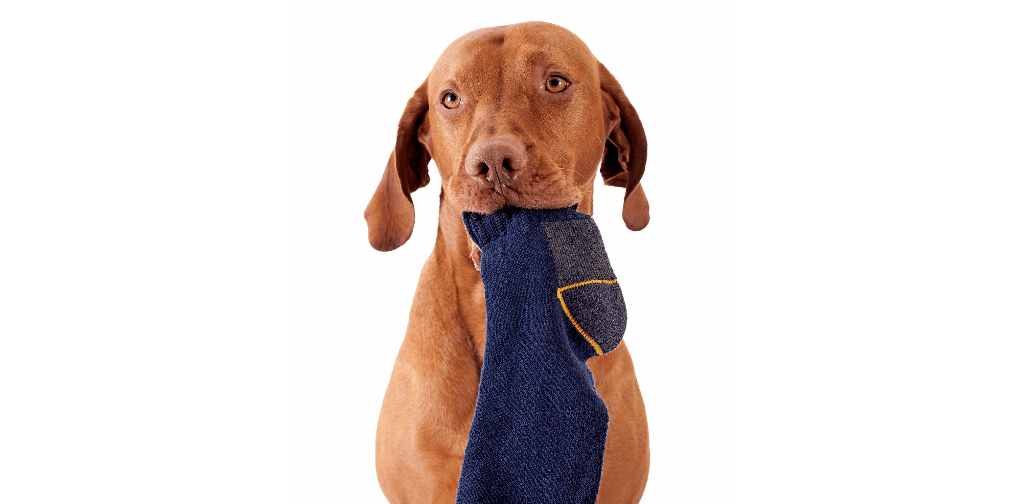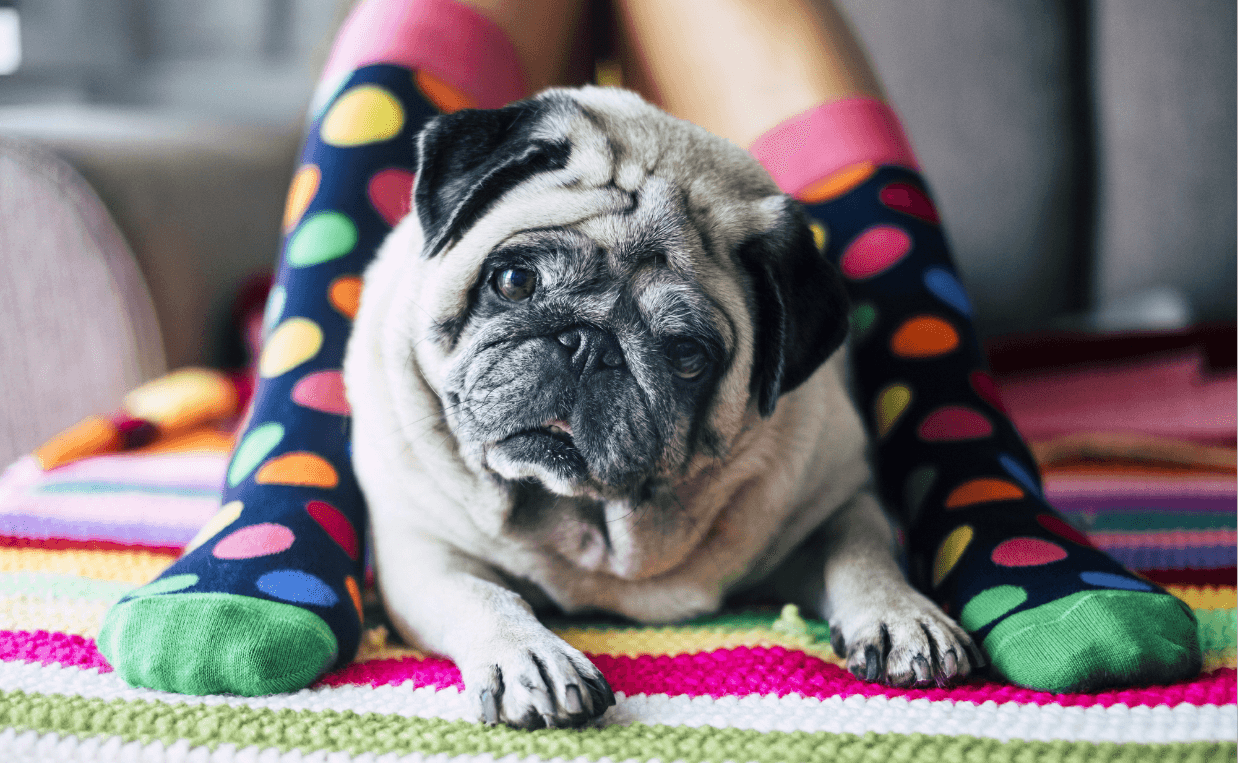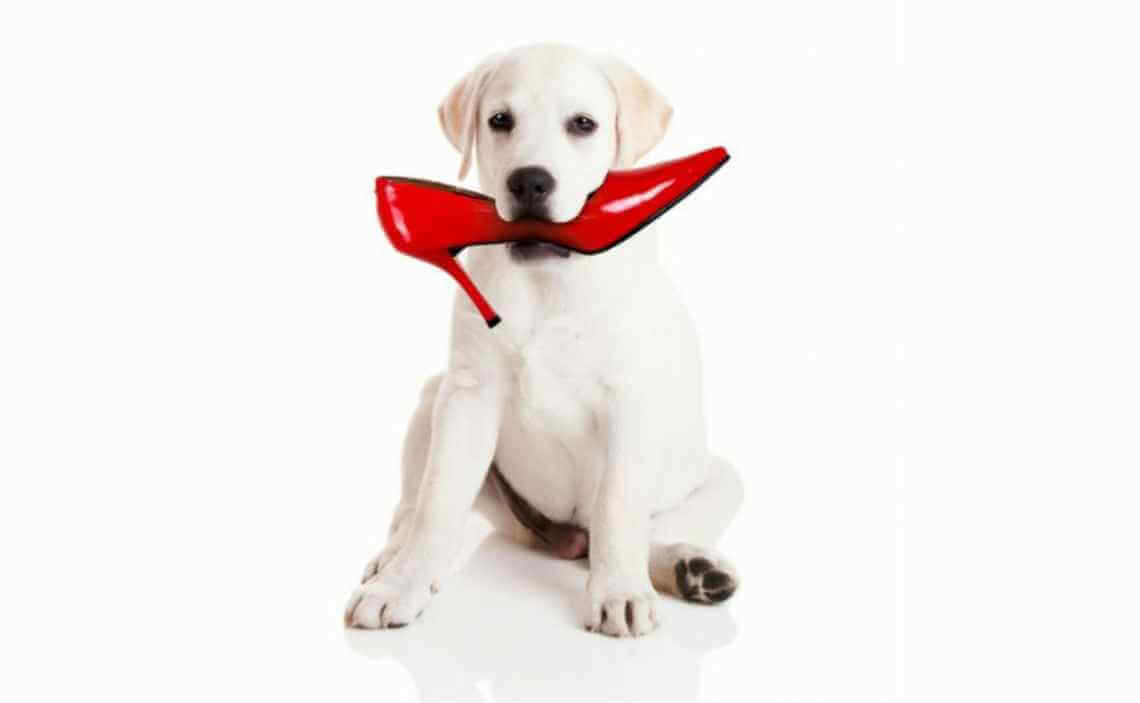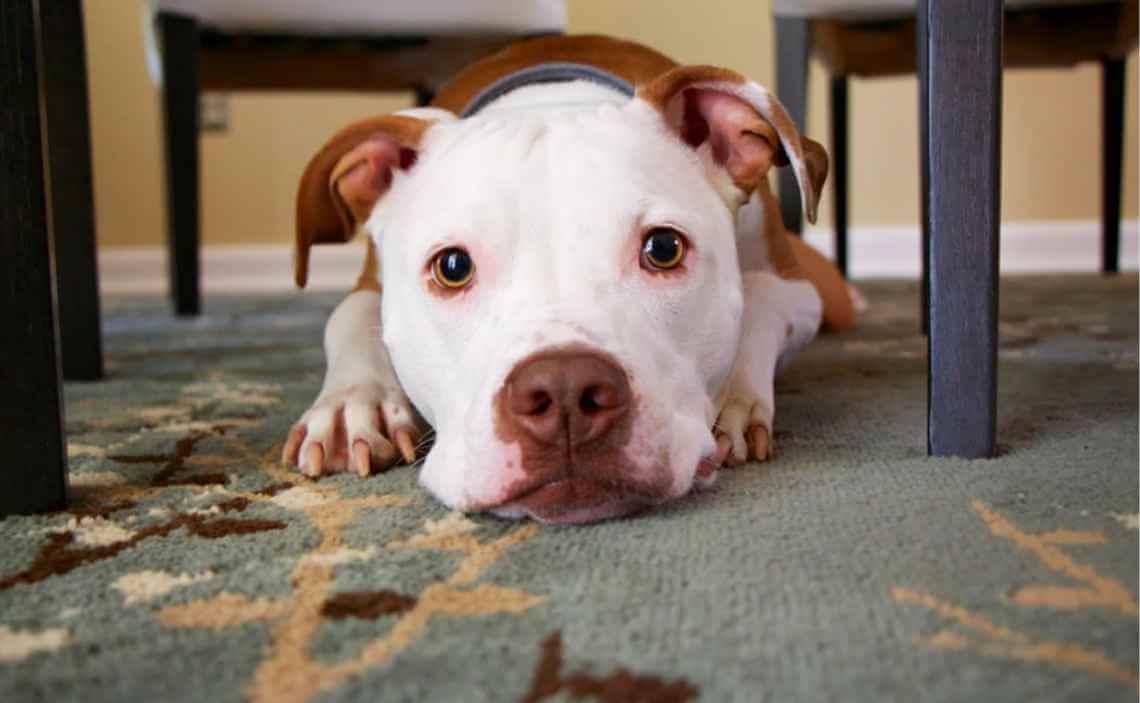
Does your dog love to chew on socks or other strange things? It’s not uncommon for dogs to chew on – and even ingest – socks and other weird items. And, the more smelly the better!
Dogs often eat things people find disgusting. Some dogs eat an astonishing amount of non-food items. As comical as it may seem, a dog who eats socks is not a laughing matter. Ingesting a sock or other non-food item may cause a serious medical issue.
Some dogs seem to be obsessed with socks. One dog, a Great Dane, ate 43 1/2 socks and had a radiograph to prove it. The dog was brought in for veterinary treatment because he was retching and vomiting; he required emergency surgery to remove the socks. The owners, who wish to remain anonymous, were mortified – they had no idea their dog had eaten so many socks!

Socks, or other foreign bodies, often can’t be digested and may cause an obstruction in the stomach or intestines. An obstruction can cause severe vomiting, lethargy, a lack of appetite and constipation. Left untreated, an intestinal obstruction can be fatal.
If your dog ingests socks or other non-edible items, don’t assume your dog will be able to pass them. It’s best to call your veterinarian right away to find out what you should do.
So why do dogs eat socks (and other weird things) and what can you do about it?

There are actually several reasons a dog might be attracted to non-food items.
-
Exploration
If your dog is still a puppy, chances are he or she is interested in socks or other non-edible items because they are something interesting to sniff and chew on. Even clean ones still have your scent on them, which is interesting and oddly comforting to a puppy.
-
Teething
Sometimes puppies chew on soft items like socks in an attempt to soothe teething pain.
-
Relieve boredom
Some dogs find socks fun to play with. They can be fun to drag around, lick and try to eat. Playing with socks gives your dog something to do when he or she is bored.

-
Attention
If you chase after your dog trying to retrieve your socks, your dog may see playing with socks as a way to get your attention.
-
Resource guarding
Some dogs find socks so valuable they will resource guard them. They might even eat them as a way to “protect” them.
-
Retrieving instincts
Retriever breeds especially enjoy carrying items of clothing around in their mouths. They have been bred to love carrying things; it isn’t surprising this instinct gets out of hand sometimes. They will usually start by chewing on the sock, which leads to swallowing.
-
Medical or psychological issues
Some dogs are compelled to eat non-edible items because they have a nutritional imbalance or compulsive behavior disorder.
If your dog consistently eats non-edible items, the place to start is to try to determine the reason your dog is so interested in the things you don’t want them eating.

-
Puppy behaviors
If your dog is still a pup, chances are he or she will grow out of this behavior. In the meantime, try to keep your socks or other things away from your dog if at all possible. Make sure your puppy has lots of toys to help ward off boredom and soothe aching gums. Try to give him or her as much attention as possible. If your pup is old enough for daycare, consider bringing him or her for regular playtime to help expend some of that puppy energy and receive the physical, mental and social stimulation he or she needs.
-
Training
The first important command to work on with your pup is “drop it” or “leave it”. Practice this skill daily with your pup.
To teach your dog “drop it” or “leave it”, let your dog chew on a toy you’re holding. Then, let the pup smell a favored treat. As soon as your pup drops the toy, give the command and then the treat. Keep practicing until your dog understands you want them to “drop it” or “leave it” when you give the command.
-
Veterinary care
If you suspect your dog is eating non-edible items out of compulsion or a mineral deficiency, make an appointment and visit your veterinarian. He or she can help you identify the cause of your dog’s behavior and make recommendations on how to help your dog lose his or her fixation on socks or other unhealthy items, especially ones that can get stuck in your dog’s intestinal tract, which can be life-threatening.

While the above methods can help address the issue of eating socks and other non-edible items, don’t be surprised if it takes a while for your pup to either grow out of his or her attraction to socks or learn other, more acceptable, behaviors. Be patient and do what you can to prevent your dog from getting your socks in the first place. Unfortunately, treatment can be expensive if your dog does ingest a sock (or socks). As with most veterinary concerns, the best treatment option is prevention.
Does your dog eat socks? How have you addressed this issue? Please share with the rest of the Canine Campus community in the comments below.

 Can Dogs Eat Hot Sauce and Other Spicy Foods?
Can Dogs Eat Hot Sauce and Other Spicy Foods? What To Do If Your Dog is Lost
What To Do If Your Dog is Lost What Are Smart Dog Collars?
What Are Smart Dog Collars? 16 Tips to Keep Your Dog Safe and Comfortable During Winter Weather
16 Tips to Keep Your Dog Safe and Comfortable During Winter Weather 5 Non-Edible Dangers for Dogs During the Holidays
5 Non-Edible Dangers for Dogs During the Holidays






Carter is a year and 8 months I think he really enjoy socks and cardboard
Awww how sweet! Thankfully the puppy-chewing stage doesn’t last forever!